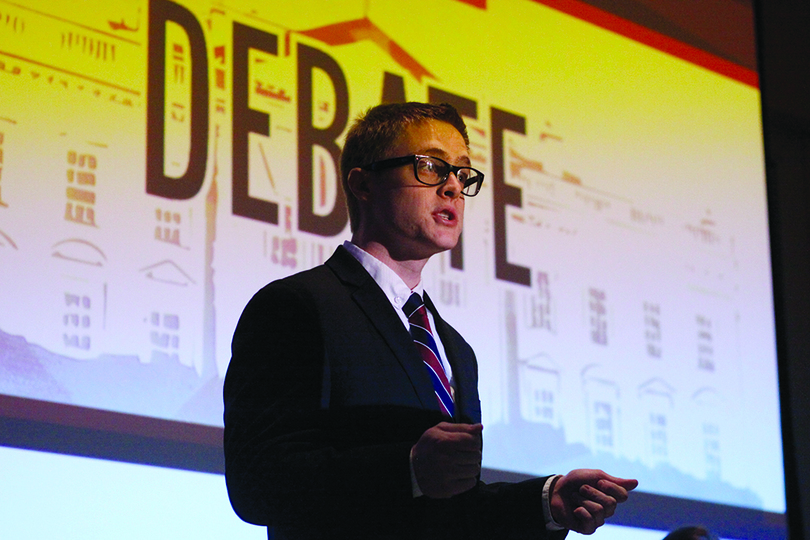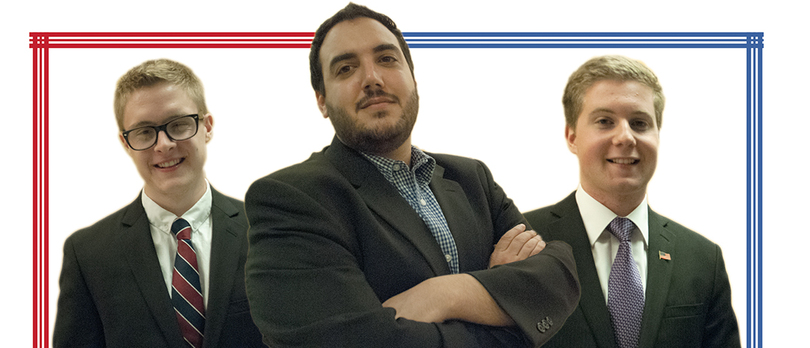The great debate: iSchool professor leads students in exploring party politics through social media, interactive campaign strategizing
Candidate Carter Rhodes leaned against the wall of the Life Sciences Complex Auditorium while waiting for the final democratic primary election result. He buried his face into his hands, looking fatigued and fretful.
President Barack Obama exchanged hostile accusations with former Gov. Mitt Romney on live TV during Tuesday’s debate. Another mock campaign, which more than 100 Syracuse University students were a part of in IST 500: “Social Media in the 2012 Election,” also reached a fever pitch on Wednesday afternoon.
Ten candidates, including Rhodes, who was portrayed by junior television, radio and film and information management and technology dual major Brad Slavin, vied for two precious spots for the final mock presidential election.
#ElectionClass, created by School of Information Studies professor and leader of the NEXIS office Anthony Rotolo, and assistant professor of public administration Ines Mergel, is divided into two separate parts.
Half of the class is spent investigating how social media interactions reflect the 2012 presidential campaign result. In the other half of the class, students run a mock presidential election, titled “A better future for Amercia.” The name for the faux nation is derived from a typo made on the original mobile app created for Romney’s 2012 campaign.
“What I want to do is to simulate what is happening in the real world through social media, but also in the environment of the election in this classroom, so that students could experience not only social media, but also its impacts on the election,” Rotolo said. “The best way to achieve that is to let students run their own campaign.”
Students divided into 14 groups. Each group had to choose a leader representing a fictional political candidate, with a persona created completely by the professor. Examples include a political satirist and television personality representing the Democratic side, and a libertarian Republican from Texas.
At the close of Wednesday’s debates, votes tweeted in by students determined that Robert Lawrence, portrayed by Bob O’Brien, a junior information management and technology major, would move into the election as the Republican candidate. Matt Diaz, portrayed by Jared Kraham, a senior broadcast journalism and political science dual major and Daily Orange conservative columnist, won the democratic ticket.
When the votes originally came in, results between Diaz and Rhodes were too close to call, so a separate tally was taken with only those two candidates, and Diaz came out the victor.
Considering that the university demographic tends to be dominantly liberal, Rotolo assigned students to roles with political agendas they didn’t necessarily believe in. He hopes the students will make voting decisions based on the candidates’ performances, as opposed to their own personal political bias.
“I am a little bit more moderate than my candidate, but it’s nice to be able to put on another hat,” said Chelsea Orcutt, a senior public relations and political science major and NEXIS worker who played Sen. Alexis Alvarez, a progressive democratic candidate in the mock debate. “It’s important for us to be on our games and do our research so that we can be able to think on our toes.”
The topics of debate range from domestic issues, like education and health care, to foreign affairs, like the relationships with China and Libya. Candidates have to conduct comprehensive researches and prepare for tough questions they might face.
While the candidates debated on stage, students sitting in the auditorium tweeted their opinions using their election class hashtag. Tweets were shown on a big screen in front of the class and updated in real time, with new statements constantly appearing on the screen. Students frequently broke into applause middebate, showing support for their candidates of choice. They stayed engrossed, listening to the debates unfolding before them.
Campaign members worked together to create campaign websites, attack videos and implement various social media outlets, including Pinterest, Twitter, Vimeo and Facebook.
That’s all in addition to ElectionClass.com, a WordPress blog where students post updates about their faux campaigns, as well as their own commentary on the actual presidential debate between Obama and Romney.
Students also have to grapple with occasional campaign dramas. There was a Twitter hacking incident that led to verbal sparring on the Internet. The campaign teams learn crisis management skills and steer the conversation on social media to the direction they want.
“It was just like a real campaign, a microcosm of the real world,” said Chris Becker, a senior information management and technology major and NEXIS crewmember.
Becker thought that those theatrical moments, like the Twitter hacking incident, provided valuable learning experiences.
He elaborated to point out how valuable it was to get what he called an “inside look” at working on a campaign and learning about the real amount of work faced by politicians today.
“You realize it’s a lot more work than they get credit for,” Becker said. “It’s a lot more than just one political face; it’s the people behind them as well.”
The highly competitive mock campaign is only one facet of this class. #ElectionClass also focuses on the real world, with iSchool students applying cutting-edge technology to track the 2012 presidential campaign dynamic on the social media platform.
Using Twitter data analytic tool Twindex, students calculate what the most tweeted moment is and monitor the level of interaction on Twitter after each presidential debate. Students also compare traditional measurement Gallup poll with the results that are perceived on social media to see if there are any correlations between Twitter activities and the actual result on Election Day.
Since late August, some students, namely Becker and Isaac Budmen, partners in startup Little Tinker and NEXIS coworkers, and sophomore information management and technology major Sean Cheatham, have begun to work on an interactive map program, creating an Electoral Map of Twitter.
The map, through tracking hashtags and conversations on Twitter, will reflect on how each state is leaning in the presidential election. It is one part of several visualization projects being worked on by NEXIS.
This innovative political analysis method, making campaign predications based on data garnered on Twitter, might be the first in the nation, Rotolo said.
Emphasizing the analytical part of the election, Rotolo believes, will help students to learn how social media strategies work in the real word. He has invited guest speakers from nonpartisan organizations like 140 Elect or Americans Elect. Rotolo said there will also be speakers from the Obama campaign after Election Day ends. They will talk not about ideologies, but lessons they learned.
Said Rotolo: “We have a lecture hall full of students who are probably going to be as informed by the election as they possibly can, regardless of the outcome.”
Published on October 18, 2012 at 3:03 am






